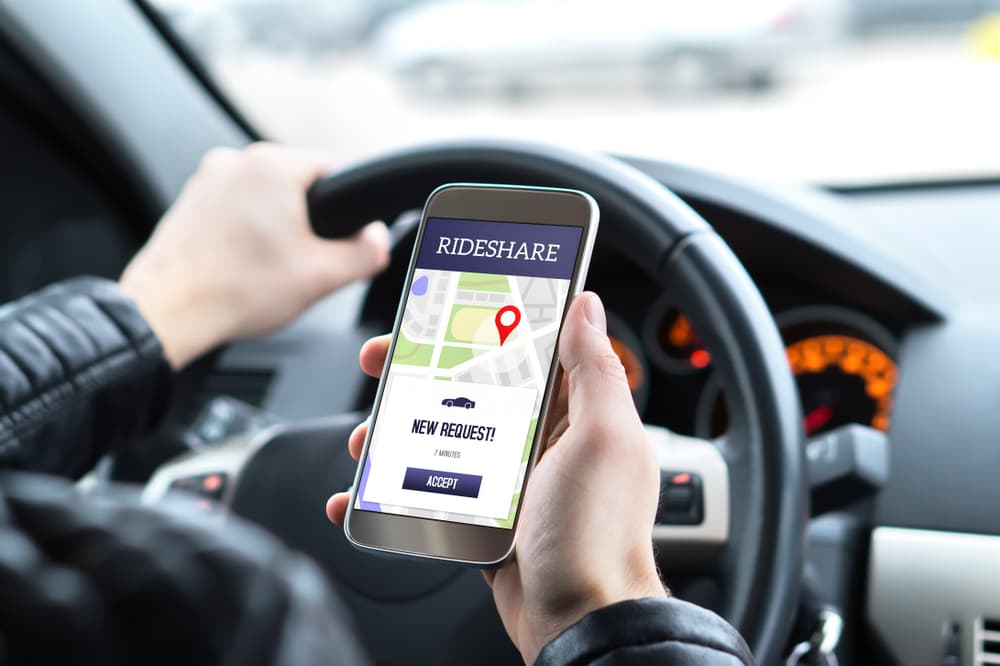Increasing numbers of people today rely on ridesharing vehicles – including Uber vehicles – for both business and recreational purposes. However, given the increased number of Uber vehicles on local roads comes the increased likelihood of accidents that involve these vehicles.
In some cases, Uber accidents occur when a negligent Uber driver violates traffic laws or engages in distracted driving. At other times, however, third-party drivers or even repair facilities may cause these crashes.
Just like any other car accident, Uber accidents may cause victims to suffer debilitating injuries, some of which may be permanent. If you sustained injuries in a recent Uber accident, a knowledgeable rideshare accident lawyer can examine the circumstances surrounding your accident and determine your legal options.
Depending on the circumstances, your Omaha rideshare accident attorney can file a claim with the Uber driver’s personal insurance company, with an at-fault third-party driver’s insurer, or under Uber Corporate’s policy. After filing a claim, your lawyer can aggressively negotiate with insurance company representatives – or litigate your case in court – to pursue the compensation you need for your accident-related losses.
How do Uber Accidents Happen and Who is Responsible?

Uber accidents can occur due to driver error, vehicle malfunction, or even road conditions.
Here’s a breakdown of how Uber accidents typically happen and who you can hold responsible for them.
- First, Uber accidents often happen because of driver negligence. Like any other driver, Uber drivers can make mistakes. These may include speeding, distracted driving, running red lights, or driving under the influence of drugs or alcohol. When an Uber driver causes an accident due to these actions, you can hold them responsible. However, since Uber drivers are considered independent contractors, you cannot always hold Uber itself directly liable for the driver’s actions.
- Other drivers may also cause Uber accidents. If another driver causes a collision with an Uber vehicle, you can hold that driver responsible for any injuries or damages. In this situation, the at-fault driver’s insurance must cover the costs.
- Additionally, Uber accidents can result from poor road conditions, such as potholes or malfunctioning traffic signals. In these cases, you can hold the government entity responsible for maintaining the roads accountable – especially if they failed to fix a known hazard. For example, if a city fails to repair a dangerous intersection and an Uber accident occurs, you can hold the local government responsible.
- Sometimes, Uber accidents happen because of mechanical issues with the vehicle. If an Uber driver’s car malfunctions due to a defect, you can hold the car manufacturer or mechanic liable. For example, if faulty brakes cause an accident, you can hold the company that made the car or repaired it improperly at fault.
Typical Injuries in an Uber Accident
Victims of Uber accidents can suffer from a wide range of injuries, depending on the severity of the collision.
These injuries can vary from minor to life-threatening and may require different types of medical care.
- One of the most common injuries in Uber accidents is whiplash. Whiplash occurs when the neck is suddenly jerked forward and then backward, often in rear-end collisions. This can lead to neck pain, stiffness, and headaches. Victims with whiplash may need physical therapy, chiropractic care, or pain medication to recover.
- Another frequent injury is broken bones. In a serious Uber accident, passengers can suffer fractures to their arms, legs, ribs, or even their skull. These injuries often require emergency treatment, such as setting the bone in place or surgery. Afterward, patients often need weeks or months of rehabilitation, including physical therapy, to regain strength and mobility.
- Head injuries, including concussions and other traumatic brain injuries (TBIs), are also common in Uber accidents. A head injury can happen if the victim hits their head on a window or seat. Concussions may cause dizziness, nausea, and confusion, while more severe TBIs can lead to long-term memory losses or cognitive issues. Treatment for head injuries often includes rest, medication, and possibly cognitive therapy for more severe cases.
- Back and spinal cord injuries can result from the force of a crash as well. These injuries may cause pain, loss of mobility, or even paralysis in severe cases. Victims often need surgery, physical therapy, or even long-term care if their injury is particularly serious.
- Internal injuries, such as damage to organs, are another concern in serious Uber accidents. These injuries may not immediately manifest but can kill if left untreated. Emergency surgery or intensive care may need to address internal bleeding or organ damage.
- Lastly, soft tissue injuries like sprains, strains, and bruises are common in Uber accidents. These injuries can cause pain and discomfort and may require rest, ice, compression, and elevation (RICE) as well as physical therapy to heal.
Proving Negligence in an Uber Accident Case
Proving negligence in an Uber accident case requires demonstrating four key legal elements: duty of care, breach of duty, causation, and damages.
These elements apply whether the negligence stems from the Uber driver or another individual, such as a third-party driver or even a vehicle manufacturer.
- First, you must prove that the negligent party owed a duty of care. All drivers, including Uber drivers and other motorists, have a legal responsibility to drive safely and follow all traffic laws. In some cases, other entities like car manufacturers owe a duty of care to provide safe vehicles.
- Second, you need to show that this duty of care was breached. For Uber drivers or other motorists, this may include speeding, running a red light, driving under the influence, or texting while driving. For a manufacturer or mechanic, the breach may involve providing faulty equipment or failing to fix a known problem with the vehicle. Evidence for a breach of duty can include police reports, traffic camera footage, or eyewitness statements. In cases involving defective parts or repair work, expert testimony or vehicle inspection reports may be required to prove the breach.
- The third element is causation, meaning you must prove that the breach of duty directly caused the accident and your injuries. For example, if an Uber driver ran a stop sign and hit another vehicle, medical records and witness statements can help show that the crash caused your injuries. Additionally, if another driver caused it or a vehicle malfunction occurred, accident reconstruction experts can explain how these factors led to the collision.
- Finally, you must demonstrate that you suffered damages as a result of the accident. Damages can include medical bills, lost income, and pain and suffering. Medical records, hospital bills, and proof of missed work time can be used to establish the financial effect of the accident. Expert testimony may also be necessary to estimate future medical costs or potential long-term disability.
Litigating an Uber Accident Case in Court
Litigating an Uber accident case in court involves several steps to prove that negligence by the Uber driver, a third-party driver, or some other individual/entity caused the accident and your injuries.
Here’s a general overview of the process:
- Initial Consultation and Case Evaluation – The first step is an initial consultation with a knowledgeable Uber accident lawyer. During this meeting, you discuss the details of the accident, including who was involved, how it happened, and the injuries sustained. The lawyer will evaluate the strength of your case and advise you on the next steps.
- Settlement Negotiations – Oftentimes, Uber accident cases are settled out of court. Your personal injury lawyer will file a claim with the appropriate insurance company and pursue a settlement to try and resolve the case without going to court. Settlements can save time and avoid the uncertainties of a trial. If you settle, you can agree to the terms and resolve the case.
- Filing a Lawsuit – If the insurance company will not offer you fair compensation, your lawyer will file a legal document called a complaint with the court. This document outlines your allegations against the defendant (the party or parties you believe are at fault) and states the damages you seek. The complaint is then served to the defendant(s), who must respond.
- Discovery Phase – Once the defendant(s) responds, both sides enter the discovery phase. This is where each side gathers evidence to support their case. This can include exchanging documents, taking depositions (formal interviews under oath), and collecting evidence such as police reports, medical records, and witness statements. For complex cases, expert witnesses may provide specialized knowledge, such as accident reconstruction or medical evaluations.
- Pre-Trial Motions and Hearings – Pre-trial motions and hearings ask the court to make certain decisions or rulings before the trial begins.
- Trial – If you cannot settle, the case proceeds to trial. Both sides present their evidence and arguments before a judge or jury.
- Verdict and Appeals – After hearing the evidence, the judge or jury will render a verdict. If you win, the court will award damages based on the evidence you presented. If the defendant loses, they may appeal the decision to a higher court.
Types of Recoverable Compensation in an Uber Accident
When you file a claim or lawsuit for an Uber accident, you can seek compensation to cover the damages you’ve suffered.
Here’s a breakdown of the main types of damages you may recover compensation for your accident-related loss:
- Medical Expenses – This compensation covers the costs of medical treatment you received due to the Uber accident. It includes hospital bills, doctor visits, surgery, prescription medications, and physical therapy. If you need future medical care related to your injuries, you can also seek compensation for those expected costs.
- Lost Income – If your injuries caused you to take time off work, you can recover compensation for the earnings you lost. This includes both the salary or hourly income you missed and any bonuses or benefits you would have earned. If your injuries affect your ability to work in the future, you may also claim compensation for reduced earning capacity.
- Pain and Suffering – This type of damage addresses the physical pain and emotional distress you experienced because of the Uber accident. It can vary based on the severity of your injuries and how they affect your daily life. Pain and suffering may include both physical discomfort and mental anguish, like anxiety or depression.
- Property Damage – If the Uber accident damaged or destroyed your personal property, you can seek compensation for the repair costs or replacement value. This includes damage to any lost or damaged personal items inside the car.
- Loss of Enjoyment of Life – If your injuries prevent you from participating in activities you enjoyed before the accident, you may recover compensation for this loss. For example, if you can no longer play sports or engage in hobbies due to your injuries, you may receive compensation for the effect on your lifestyle.
- Punitive Damages – These damages punish the at-fault party or parties for particularly reckless or malicious behavior and deter others from acting similarly.
The compensation for damages addresses different aspects of the harm you suffered and helps you recover as fully as possible.
Speak with a Knowledgeable Uber Accident Lawyer about Your Case Today

If you recently sustained injuries in an Uber accident that resulted from an Uber driver’s or someone else’s negligence, retain an experienced Omaha personal injury lawyer skilled at rideshare accidents for representation right away.
A knowledgeable Uber accident attorney can handle all of the legal steps for you and pursue the maximum compensation you deserve to recover for your losses.